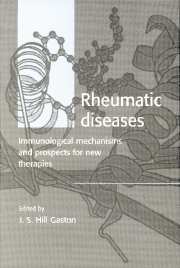Book contents
- Frontmatter
- Contents
- List of contributors
- 1 Implications of advances in immunology for understanding the pathogenesis and treatment of rheumatic disease
- 2 The role of T cells in autoimmune disease
- 3 The role of MHC antigens in autoimmunity
- 4 B cells: formation and structure of autoantibodies
- 5 The role of CD40 in immune responses
- 6 Manipulation of the T cell immune system via CD28 and CTLA-4
- 7 Lymphocyte antigen receptor signal transduction
- 8 The role of adhesion mechanisms in inflammation
- 9 The regulation of apoptosis in the rheumatic disorders
- 10 The role of monokines in arthritis
- 11 T lymphocyte subsets in relation to autoimmune disease
- 12 Complement receptors
- Index
10 - The role of monokines in arthritis
Published online by Cambridge University Press: 06 September 2009
- Frontmatter
- Contents
- List of contributors
- 1 Implications of advances in immunology for understanding the pathogenesis and treatment of rheumatic disease
- 2 The role of T cells in autoimmune disease
- 3 The role of MHC antigens in autoimmunity
- 4 B cells: formation and structure of autoantibodies
- 5 The role of CD40 in immune responses
- 6 Manipulation of the T cell immune system via CD28 and CTLA-4
- 7 Lymphocyte antigen receptor signal transduction
- 8 The role of adhesion mechanisms in inflammation
- 9 The regulation of apoptosis in the rheumatic disorders
- 10 The role of monokines in arthritis
- 11 T lymphocyte subsets in relation to autoimmune disease
- 12 Complement receptors
- Index
Summary
Introduction
Rheumatoid arthritis (RA) is generally considered an autoimmune disease, with its main manifestation a chronic inflammatory process in the synovial tissues of multiple joints and concomitant local destruction of cartilage and bone. RA synovial fluid is predominantly enriched with neutrophils, whereas the most abundant cells in the synovial tissue are macrophages and T cells, with foci of plasma cells and variable degrees of fibroblast proliferation. Another characteristic feature is the considerable thickening of the synovial lining layer, comprising macrophage-like type A cells and fibroblast-like type B cells. A major site of cartilage and bone destruction originates from overgrowth of activated synovial tissue at the margins, the so-called pannus tissue, although cartilage destruction away from overgrowth is noted as well. A key ongoing issue of debate in this destructive process is whether it is mainly linked to the inflammatory infiltrate in the synovial tissue or whether autonomous activation of synovial tissue fibroblasts and macrophages is a major event. There is at least suggestive evidence from transfer studies in SCID mice that RA synovial tissue cells are potentially destructive and may cause substantial cartilage damage in the absence of T cells. Apart from mechanism of the destructive process, there is also a longstanding debate on chronic synovitis: is it a dominant T cell-dependent immune inflammation or does it reflect perpetuated activation of synovial fibroblasts and macrophages, with secondary but minor involvement of T cells. Arguments for the latter hypothesis are based on the detection of an abundance of macrophage-derived cytokines (monokines) in the RA synovial tissue and the relative paucity of T cell factors (Firestein & Zvaifler, 1990; Firestein, Alvaro-Garcia & Maki, 1990).
- Type
- Chapter
- Information
- Rheumatic DiseasesImmunological Mechanisms and Prospects for New Therapies, pp. 203 - 224Publisher: Cambridge University PressPrint publication year: 1999



